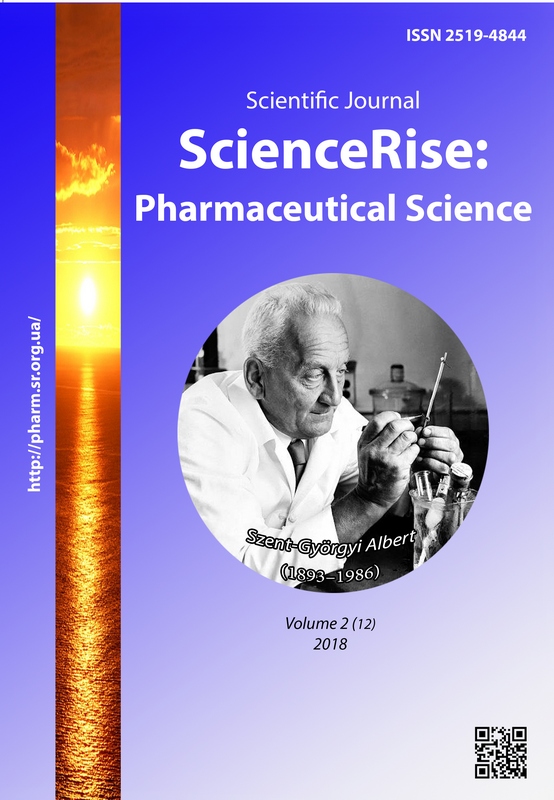The substantiation of the selection of medicinal plants and their rational application in diseases of the hepatobiliary system
DOI:
https://doi.org/10.15587/2519-4852.2018.129642Keywords:
medicinal plants, selection methodology, rational use, hepatoprotective action, choleretic actionAbstract
Aim of the work. The aim of the work was to develop methodological approaches to justify the selection of medicinal plants and phytopreparations for diseases of the hepatobiliary system and to determine aspects of their rational use.
Methods. The studies were carried out by analyzing the scientific literature data and the results of our own experimental studies on determining the influence of groups of plant biologically active substances (BAS) on the links of the pathological process in diseases of the liver and bile ducts.
Results. Hepatoprotectors of plant origin are quite a large group of drugs and account for more than half of all hepatoprotectors available on the pharmaceutical market. Among the popular medicinal plants and preparations based on them (mono- and multicomponent), the silybum marianum, the artichoke, the fumarium officinalis, the main groups of active substances are flavonoids, hydroxycinnamic acids and alkaloids, respectively. However the spectrum of medicinal plants (and groups of biologically active substances) that is used to prevent and treat diseases of the hepatobiliary system is much broader. Therefore, the article substantiates the necessity of developing an algorithm for the selection of medicinal plants for the treatment of diseases of the hepatobiliary system, which is based on the definition of the main etiological and pathogenetic aspects of liver and biliary tract diseases, the peculiarities of the use of medicinal plants whose spectrum is determined by different groups of biologically active compounds.
Conclusions. Based on scientific data on the etiology, the main links of the pathological process and clinical and biochemical syndromes of diseases of the hepatobiliary system was presented the directions of treatment of these diseases with plant products. The necessity of development of methodological approaches to justify selection of medicinal plants and phytopreparations for diseases of the hepatobiliary system and to determine the aspects of their rational use is substantiated. The basic principles of the use of medicinal plants for diseases of the liver and bile ducts are formulated
References
- Filippova, O. Yu. (2011). Mozhlyvosti fitoterapii u likuvanni nealkoholnoi zhyrovoi khvoroby pechinky. Suchasna hastroenterolohiia, 2 (58), 116–122.
- Hrytsyk, A. R., Huzko, N. M., Posatska, N. M. (2007). Poshuk likarskykh roslyn, yaki zastosovuiutsia dlia likuvannia zakhvoriuvan hepatobiliarnoi systemy. Fitoterapiia, 2, 47–51.
- Mierkulov, R. (2017). Mozhlyvosti fitoterapii v likuvanni khronichnykh zakhvoriuvan pechinky ta zhovchovyvidnykh shliakhiv. Zdorov’ia Ukrainy, 24, 39.
- Mubarakshina, O. A. (2008). Gepatoprotektory: sravnitel'naya kharakteristika i aspekty klinicheskogo ispol'zovaniya. Meditsinskiy vestnik, 34, 51–55.
- Busalaeva, E. I., Tarasova, L. V., Matveeva, T. S. (2015). Gepatoprotektory v klinicheskoy praktike. Algoritm vybora. Zdravookhranenie Chuvashii, 2, 56–64.
- Mekhtiev, S. N., Okovityi, S. V., Mekhtieva, O. A. (2016). Printsipy vybora gepatoprotektorov v praktike terapevta. Lechashhiy vrach, 8, 44–53.
- Baykova, I. E., Nikitin, I. G. (2013). Lekarstvennoe porazhenie pecheni. Russkiy meditsinskiy zhurnal, 2, 7–15.
- Morozov, S. V., Kucheryavyi, Yu. A. (2011). Gepatoprotektory v klinicheskoy praktike: ratsional'nye aspekty ispol'zovaniya: posobie dlya vrachey. Moscow: 4TE Art, 28.
- Kramarev, S. A. (2011). Sovremennye gepatoprotektory v gepatologii. Dytiachyi likar, 1, 5–9.
- Vovk, E. I. (2010). Rastoropsha v sovremennoy gepatologii: estafeta pokoleniy iz Drevney Gretsii v nashi dni. Russkiy meditsinskiy zhurnal, 30, 18–37.
- Saller, R., Melzer, J., Reichling, J., Brignoli, R., Meier, R. (2007). An Updated Systematic Review of the Pharmacology of Silymarin. Complementary Medicine Research, 14 (2), 70–80. doi: 10.1159/000100581
- Mokhort, M. A., Seredynska, N. M., Kyrychok, L. M., Myslyvets, S. O. (2009). Hepatoprotektorni vlastyvosti likarskykh zasobiv, vyhotovlenykh na osnovi artyshoku posivnoho. Farmakolohiia i likarska toksykolohiia, 3 (10), 33–37.
- Sotskaya, Ya. A. (2009). Vliyanie kombinatsii antralya i artikhola na kontsentratsiyu tsirkuliruyushhikh immunnykh kompleksov i ikh molekulyarnyy sostav v krovi bol'nykh khronicheskim nekal'kuleznym kholetsistitom, sochetannym s khronicheskim virusnym gepatitom S minimal'noy stepeni aktivnosti v periode meditsinskoy reabilitatsii. Ukrainskyi medychnyi almanakh, 12 (1), 12–19.
- Glushchenko, A. V., Georgiyants, V. A., Perekhoda, L. A. (2015). Docking studies of the chemical components of the composition of Bupleurum aureum plant in relation to hepatoprotective biotargets. Der Pharma Chemica, 7 (4), 201–206.
- Glushchenko, A. V., Perekhoda, L. A., Georgiyants, V. A., Naboka, O. I., Samer, K. (2015). Application of molecular doсking for studying the hepatoprotective activity of Hill-growing Saltwort Herb. Journal of Chemical and Pharmaceutical Research, 7 (3), 2219–2223.
- Zhuravleva, L. V., Krivonosova, E. M. (2013). Sravnitel'naya kharakteristika gepatoprotektornykh sredstv: klyuch k ratsional'nomu primeneniyu. Sovremennaya gastroenterologiya, 4 (72), 93–101
- Tkach, S. M. (2009). Effektivnost' i bezopasnost' gepatoprotektorov s tochki zreniya dokazatel'noy meditsiny. Zdorov'e Ukrainy, 6, 7–10.
- Eritsland, J. (2000). Safety considerations of polyunsaturated fatty acids. The American Journal of Clinical Nutrition, 71 (1), 197–201. doi: 10.1093/ajcn/71.1.197s
- Morozov, S. Yu. (2009). Gepatoprotektory v praktike vracha-klinitsista. Russkiy meditsinskiy zhurnal, 1, 4–9.
Downloads
Published
How to Cite
Issue
Section
License
Copyright (c) 2018 Alla Glushchenko, Inna Vladymyrova, Victoriya Georgiyants

This work is licensed under a Creative Commons Attribution 4.0 International License.
Our journal abides by the Creative Commons CC BY copyright rights and permissions for open access journals.








